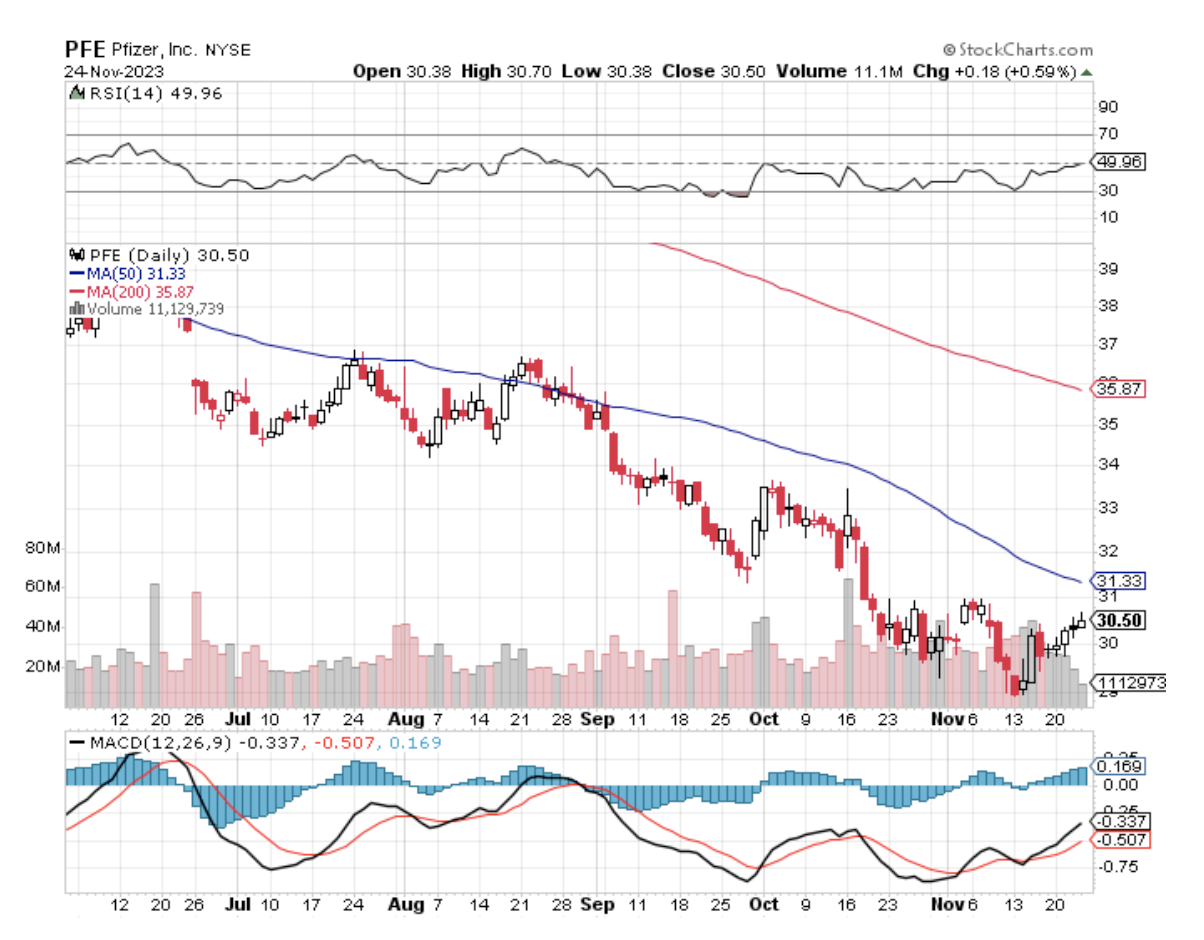Eli Lilly's (LLY) recent strides in the weight-loss treatment market have made headlines, especially with Mounjaro, their diabetes drug doubling as a weight-loss medication. The real buzz began when Zepbound, another of Lilly’s offerings, got the green light for weight management.
These developments have propelled Lilly into a potentially profitable orbit, but let's not get carried away just yet. While this company’s stock has been climbing the ladder, partly priced in with the latest news, it's worth casting a wider net.
In the world of pharmaceuticals, opportunities abound, and sometimes the best catches are not the shiniest. Enter Pfizer (PFE), a familiar name that’s been a bit under the weather, stock-wise.
Pfizer's shares have taken a 40% hit this year, a response to the waning demand for their COVID-19 vaccine and treatment.
But let's not forget that we're shifting gears to a post-pandemic era, and such shifts in demand are part of the course. Add to this the impending loss of exclusivity on some of their key products, and you've got a recipe for some financial heartburn.
In 2023, Pfizer’s performance didn’t quite match up to the market, a stark contrast to its 2021 and 2022 glory days, driven by its COVID-19 portfolio. However, looking at Pfizer through the narrow lens of recent performance alone is like judging a book by its last chapter.
Let's rewind a bit. Pfizer took some bold steps in recent years, steps that have shaped its current narrative.
The big move was shedding its consumer health and off-patent drug business, Upjohn, which led to the creation of Viatris (VTRS). The goal? To sharpen focus on innovative pharmaceuticals.
Then came the historic collaboration with BioNTech (BNTX) on a COVID-19 vaccine, marking the first U.S. authorization for an mRNA-based vaccine and bringing in substantial revenue in 2021 and 2022.
Fast forward to 2023, and Pfizer's investment fruits are beginning to ripen. This year alone, it has launched seven new products, from Litfulo for alopecia areata to the RSV vaccine Abrysvo.
Pfizer's non-COVID revenue forecast is promising, projecting up to $84 billion by 2023.
But the plot thickens. Pfizer recently announced a $43 billion acquisition of Seagen (SEGN), an oncology-focused biotech. This isn’t just a new chapter for Pfizer; it’s a whole new book, potentially leading to groundbreaking developments in cancer treatment.
With these in mind, it’s reasonable to believe that Pfizer’s current stock-market blues are but a temporary cloud.
With 83 candidates in development and a robust pipeline, partly fueled by its COVID-19 success, a rebound is on the horizon.
The dividend yield, sitting pretty at 5.5%, along with a decade-long streak of increasing payouts, adds to Pfizer's charm as a long-term investment.
So, investors should see Pfizer’s current price not as a red flag but as a golden ticket – an opportunity to get in on the ground floor before the elevator goes up. Its revenue forecast doesn’t even include its COVID-19 products, which could continue to generate significant revenue, especially during flu season.
Now, back to Eli Lilly. Yes, its revenue has seen double-digit growth recently, and it has been facing the same headwinds as Pfizer. It’s important to note, though, that its valuation makes sense in the context of its current earnings and potential growth. That makes it difficult to truly make a fair comparison at this point.
But, if we're talking opportunity, Pfizer is the one that's looking like a hidden gem. To put it simply, it's all about opportunity cost.
Pfizer, at present, is the underdog with untapped potential. Investing in Pfizer now could mean reaping substantial rewards down the line.
I’m talking about a company with a proven track record, a solid pipeline, and a knack for innovation. And for its current valuation, Pfizer is a deal that's hard to pass up.
For investors willing to play the long game, this could be the moment to seize an opportunity that could pay dividends in the future.

